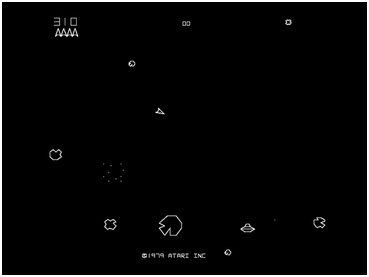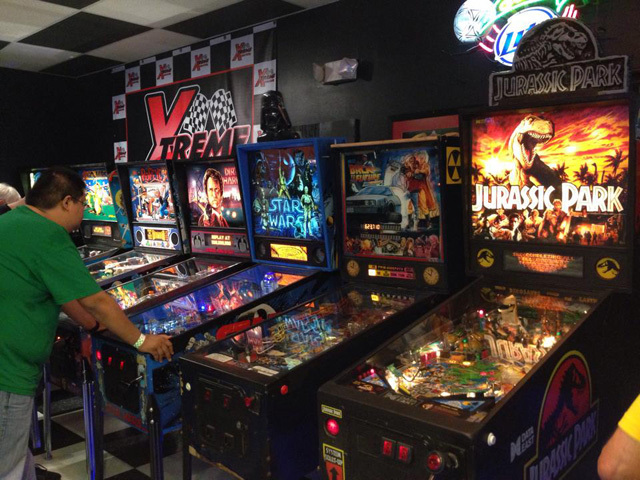February is already here (where does the time ago?), and that means it’s time for another episode of Getting Good!
This time, we’ll be talking about another timeless classic: Asteroids. This is a game that is on par with the big ones that we’ve mentioned in the past such as Pac-Man and Donkey Kong. Developed by Atari and released in 1979, Asteroids is a product of the ‘space-age’ of video games, back when the moon landing was still somewhat fresh in the public’s collective consciousness. This achievement helped not only to further the cause of humankind and to advance our knowledge of the universe, it also single-handedly spawned an entire genre of video games based on both the marvels and horrors of outer space.
Case in point, Asteroids is a space shooter, and a very different one at that. Unlike most space shooters of the period, which consist of traversing through stages from left to right (or upwards, in vertical fashion), Asteroids pit the player in an arena of sorts, surrounded by a number of, you guessed it, asteroids. The objective of the game is to maneuver your spaceship across the field and shoot down the asteroids to get points. Upon shooting an asteroid, it will split into smaller rocks, and so on until completely destroyed. Periodically, several saucers may enter the arena from the sides, and shooting these down will grant the player additional points.
When it comes to gameplay, Asteroid’s formula is simple. Like many other games before it, its mechanics are simple to learn, yet difficult to master. Nevertheless, this didn’t stop the game from being hugely successful, selling around 60,000 arcade cabinets across the world. It’s fame was long-lived, as the game was ported to several platforms, and directly influenced the development of games such as Defender, Gravitar and, more recently, the indie arcade game, Cosmotrons.
In this article, we’ll go over the basics you’ll need to know in order to survive, and excel at this game.
Elements of the Game
When it comes to getting good at Asteroids, the player must do more than simply mash keys and hope to win. Like all other games, the players will have to familiarize themselves with a number of elements in order to attain the high score:
- Spaceship: The single most important element of them all. If the spaceship is destroyed, and you have no more lives, the game is over. The spaceship can rotate left or right and thrust forward. Furthermore, since we’re in space, inertia plays a role as the ship will continue to move forward a short distance after releasing the thrust button.
- Asteroids: The main objective of the game. These rocks come in three sizes: large, medium, and small. After destroying one, 2 of the smaller-sized asteroids will appear. If you destroy the smallest rocks, they will be removed from play. The large rocks are the easiest targets; not only are they very big, but they move very slow, as well. The smallest rocks, on the other hand, are very fast and difficult to hit.
- Saucers: The bonus elements of the game. These saucers come only from the sides of the stage, and can be shot down for extra points. The large saucers move slowly and shoot randomly across the stage. The small saucers, however, aim directly at the player when shooting, and can sometimes even track their movements with their shots, which makes it difficult to dodge. The large saucers grant 200 bonus points, while the small ones grant a whopping 1000 points when destroyed.
Gameplay Tips
As a general of thumb, you’ll want to take things slow from the very start. You might think that the big rocks should be destroyed all at once, since they’re so slow and make for easy targets. However, if you aim for the big rocks at the start, you’ll be surrounded by fast-moving small rocks which will make short work of your spaceship. For this reason, you’d better deal with all the small asteroids before tackling the next big one.

When it comes to space saucers; these should be priority #1. As soon as a saucer appears, a distinctive sound accompanies the UFO. Focus on destroying these in a timely manner to better rack up higher scores. Furthermore, leaving saucers alive will increase your odds of getting destroyed, as getting hit by a stray bullet becomes a very real threat as soon as one of these enemies appear on the field. To add insult to injury, stray bullets may also destroy asteroids, creating smaller rocks that you might not be prepared to deal with. Keep in mind that, after you pass the 10,000 point mark, only harder-to-hit (but more valuable) small saucers will appear from that point forward.
Saucers are the key to a long game, as every 10,000 points grants the player an extra life. In this sense, destroying everything but 1 or 2 small asteroids will set the stage for ‘farming’ small saucers. By setting the field to ambush these enemies, a player can accrue massive amounts of points in no time at all, allowing him or her to receive and unreasonable amount of extra lives for increased survivability. However, if you’re going to set an ambush for oncoming saucers, you better stick around in the middle of field, because if you wait at the sides, you might get struck by the oncoming asteroids that mark the beginning of the next round. That being said, adaptability is key when it comes to excelling at Asteroids.
And that’s all there is to it. One more thing, though: the hyperspace button allows a player to instantly disappear from their current position, and appear in another random location. This is good for emergencies, as it can help you avoid an oncoming bullet or asteroid in a pinch. However, it can also put you in the path of an enemy or space rock, potentially cutting your game short. That being said, be sure to use this feature only in emergencies.
Here at PrimeTime Amusements, we like to keep ahead of the curve in arcade game rental and sales and pride ourselves in providing the best service in the country. If you’re looking for a game in particular, or have a few questions about the industry, feel free to give us a call at 1.800.550.0090 or to swing by at 5300 Powerline Rd. Suite 210, Ft. Lauderdale, Florida, 33309.





